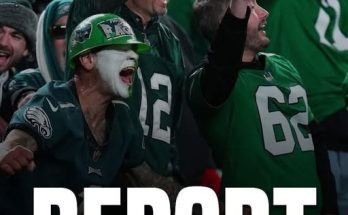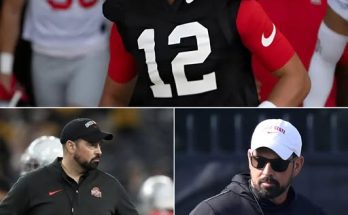It begins, as most conspiracy theories do, with a sudden shift—an abrupt coaching decision, a bizarre play call, a transfer that makes no sense. Some point back to the abrupt and controversial firing of Gus Malzahn, claiming it was less about performance and more about internal politics and power struggles within Auburn’s booster network. Others zero in on Bryan Harsin’s infamous and brief tenure, suggesting that forces far beyond the football field were responsible for the chaos that surrounded his time on the Plains. A certain group of fans believe Auburn’s powerbrokers—wealthy donors and influential alumni—have been orchestrating moves behind the scenes, playing a chess game with coaches, staff, and even players as the pawns.
Goodman, a longtime observer of the sport, doesn’t claim to have all the answers—but he acknowledges the evidence that keeps fans talking. One thread leads to another. Every odd loss or suspicious decision adds a new layer to the theory. A poorly timed quarterback change. A sudden wave of decommitments. A questionable fourth-down call in a key SEC matchup. Conspiracy theorists are quick to latch on to any misstep, seeing it as further proof that the program is being manipulated from above. They argue that true football decisions have taken a back seat to internal power dynamics. And once that idea takes root, it’s hard to shake.
The smoke around these theories thickened during the Harsin era. When the program began to unravel, some fans insisted it wasn’t entirely Harsin’s fault. They believe he was set up to fail—that his lack of Alabama ties made him an outsider from the start, a threat to the entrenched power structure that quietly controls Auburn football. When allegations began to swirl—ranging from locker room dysfunction to recruiting disinterest—it only added fuel to the fire. Though an internal inquiry ultimately cleared Harsin of wrongdoing, the damage was done. The whisper campaign had worked, and the conspiracy theory evolved into something closer to accepted truth among certain corners of the fanbase.
When Hugh Freeze was hired, many hoped that the ghosts of Auburn’s past would finally be put to rest. But for some, Freeze’s arrival raised even more questions. Was he really the best man for the job, or was he the most willing to play ball with those pulling strings behind the scenes? Supporters argue that Freeze is a proven SEC coach with the ability to lead Auburn back to national relevance. Skeptics, though, wonder if his hire was more about relationships and backdoor deals than football merit. The whispers don’t stop. They morph, they multiply, and they echo through the message boards and podcasts that have become the lifeblood of modern fandom.
It doesn’t help that Auburn’s rollercoaster seasons continue to provide conspiracy theorists with fresh material. A surprising upset win is painted as a distraction tactic. A blowout loss becomes evidence of internal sabotage. Even the smallest moves—an offensive coordinator change or a recruit flipping to a rival—are examined under the microscope of suspicion. For outsiders, it might all seem a bit far-fetched. But for those who’ve followed the Tigers for decades, it all feels just plausible enough to keep the theory alive.
Goodman notes that part of what fuels the theory is Auburn’s history of volatility. Unlike some of its SEC peers, the program has rarely enjoyed long-term stability. It often soars high one season only to plummet the next, with internal drama frequently making headlines alongside on-field performance. There’s a sense that Auburn can’t get out of its own way—that something always seems to go wrong just when things are starting to look right. For conspiracy believers, this isn’t just bad luck. It’s part of the plan.
Then there’s the boosters—the invisible hand that looms over many major college football programs, but seems particularly present at Auburn. The theory holds that a select group of ultra-wealthy donors effectively run the show, using their influence to steer decisions on coaching hires, recruiting priorities, and even game strategy. Coaches who push back are quickly pushed out. Those who cooperate find themselves in more secure footing, at least until the winds shift again. It’s a dynamic that’s difficult to prove but impossible to ignore, especially when coaching searches end in surprise hires or strange about-faces.
In this world, even media coverage becomes suspect. Analysts who praise the program are seen as mouthpieces. Critics are labeled as outsiders who “don’t understand Auburn.” The conspiracy doesn’t just live on message boards—it’s seeped into every level of discourse surrounding the program. Fans debate it over tailgate grills and in online forums. Some claim insider knowledge. Others dismiss it all as tinfoil-hat nonsense. But nobody ignores it. It has become part of the Auburn football identity—an unshakable, if unofficial, storyline that weaves through every season.
Goodman doesn’t pretend to have the master key to the truth. But he understands why the theory persists. College football is about more than just Xs and Os. It’s about loyalty, legacy, pride, and passion. When things don’t go as expected, fans look for explanations. And when those explanations aren’t satisfying, they look deeper. Sometimes, they find smoke. Sometimes, they imagine fire. And sometimes, they find just enough of both to keep the story going.
What’s undeniable is that Auburn remains one of the most fascinating programs in the sport. Its highs are as high as any school in America. Its lows are deep and dramatic. That volatility is a breeding ground for conspiracy. And with every unexpected turn, the theory only gains strength. Whether or not there’s truth to it, the belief in a hidden hand controlling the Tigers’ fate has become part of the lore. It’s an open secret, whispered but never quite spoken aloud—except by fans, by former players, and sometimes, by reporters who know better than to completely dismiss it.
The Freeze era may yet bring stability. If he wins, winning will be the narrative. But if the Tigers stumble, if the team underperforms, if key players leave or strange decisions start stacking up again, the theory will re-emerge with a vengeance. It always does. It lives in the shadows, waiting for its moment.
In a sport full of drama, Auburn has always managed to supply more than its share. The conspiracy theory is part of that. Maybe it’s fiction. Maybe it’s not. But in the world of college football, perception often carries just as much weight as truth. And at Auburn, the perception that something deeper is at play isn’t going anywhere anytime soon.
So the next time a game takes an odd turn or a coaching rumor explodes out of nowhere, don’t be surprised when Auburn fans start whispering again. Don’t be shocked when old names and old rumors resurface. Don’t be too quick to roll your eyes. Because for the Tiger faithful, Goodman’s words hit home: this conspiracy theory just won’t die. And maybe—just maybe—it’s because there’s more to the story than anyone’s willing to admit.



